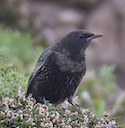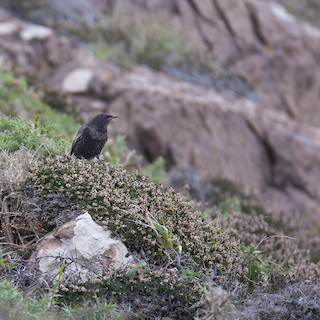 This member of the thrush family is easily mistaken at a distance for its cousin, the Blackbird, but a closer look gives the game away. A passage migrant across The Lizard, you may be fortunate and spot one in spring or autumn.
This member of the thrush family is easily mistaken at a distance for its cousin, the Blackbird, but a closer look gives the game away. A passage migrant across The Lizard, you may be fortunate and spot one in spring or autumn.
Photo: © Richard Birchett
Scientific name: Turdus torquatus
Other common names: Mountain Blackbird, Michaelmas Blackbird (because their autumn migration coincides with Michaelmas), Mountain Colley, Hill Chack
UK conservation status: Red: Birds of UK Conservation Concern; UK Biodiversity Action Plan priority species
What to look for:
• Colouring and appearance: Thrush-sized, black (females are more brown) with white gorget (crescent shaped band across the breast). The gorget is bright in males and more varied (from equally bright to less well-defined) in females. Juveniles are duller, with a brown colouring. Males have white and females pale tips to the wing and some body feathers.
• Size: Length, 20 cm; Wingspan, 40 cm.
• Where: Upland areas of the UK during the breeding season; passage migrants further south in the spring and autumn.
• Call: A rather mournful cry during the breeding season.
• Similar species: Blackbird
 At a distance, you’d be forgiven for mistaking this member of the thrush family as the more common Blackbird. Get a bit closer, or look through binoculars, and you’ll see the differences. A little smaller, slimmer and longer-tailed than its cousin, and with a white crescent-shaped collar across its breast that gives it its name – this is a Ring Ouzel. The white crescent (called a gorget) is usually more marked in males, but females vary, ranging from a white band as bright as in males to a less well-defined gorget. Males have white tips to their wing and some body feathers, giving them a silvery shimmer, and the pale brown feather tips in the females are no less distinctive.
At a distance, you’d be forgiven for mistaking this member of the thrush family as the more common Blackbird. Get a bit closer, or look through binoculars, and you’ll see the differences. A little smaller, slimmer and longer-tailed than its cousin, and with a white crescent-shaped collar across its breast that gives it its name – this is a Ring Ouzel. The white crescent (called a gorget) is usually more marked in males, but females vary, ranging from a white band as bright as in males to a less well-defined gorget. Males have white tips to their wing and some body feathers, giving them a silvery shimmer, and the pale brown feather tips in the females are no less distinctive.
Ring Ouzels are summer migrants to the UK, arriving here in the spring. Sightings on The Lizard are likely to be transient, as these are birds of the upland moors, with most pairs breeding in the craggy and wild uplands of Scotland, Wales, Northern Ireland and northern areas of England, with a more southerly breeding population among the tors of Dartmoor. Their wintering grounds are among the mountains of north-west Africa and southern Spain.
 Ring Ouzels are shy birds, nesting among heather and rocky crags, in remote places that are easier to protect from predators such as stoats and weasels, and away from the tracks beaten by hill walkers. They’ll often raise two broods during the season, with the female laying her pale blue, brown-mottled eggs close to the ground. She incubates her eggs for around two weeks, and the hatchlings are fed on worms and insects. Fledging occurs after another two weeks. The species is omnivorous, dining on insects, worms and berries. In the autumn, they actively seek out juniper berries.
Ring Ouzels are shy birds, nesting among heather and rocky crags, in remote places that are easier to protect from predators such as stoats and weasels, and away from the tracks beaten by hill walkers. They’ll often raise two broods during the season, with the female laying her pale blue, brown-mottled eggs close to the ground. She incubates her eggs for around two weeks, and the hatchlings are fed on worms and insects. Fledging occurs after another two weeks. The species is omnivorous, dining on insects, worms and berries. In the autumn, they actively seek out juniper berries.
Although considered of low conservation concern elsewhere, in the UK this species is red-listed, due to a worrying decline in breeding pairs over the last few decades. In Galloway, once a stronghold for them, they are now extinct as a breeding population.
Did you know…?
… The average lifespan of a Ring Ouzel is just two years, but the UK’s longest-lived ringed individual survived a little over nine years.
More information and references:
Svensson, L., Mullarney, K., Zetterstrom, D.,1986. Collins Bird Guide, second edition (translated by Christie, D., Svensson, L.). HarperCollins, London.
Published: May 2020
Author: Amanda Scott
Photos: Upper – © Richard Birchett (website and YouTube channel); lower – Paco Gómez / CC BY-SA
